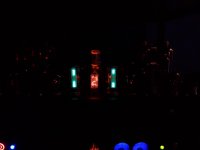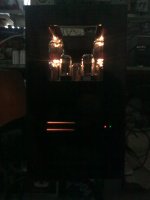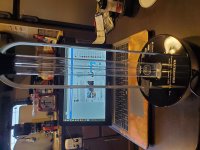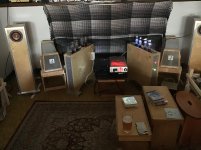The Mk3 build which I have finally stabilised. A modified mullard 5-20 based on the dynaco modified A420 design with a few tweaks to both suit my hardware and modernise it with a CCS. (Big thanks go to baudouin0 for helping with the design and the nightmare I had getting it stable with gNFB)
I think I may be a better photographer than amp builder. I'm extremely pleased with it. I still need to build this design into a new more compact chassis Mk4 final build as a pair.
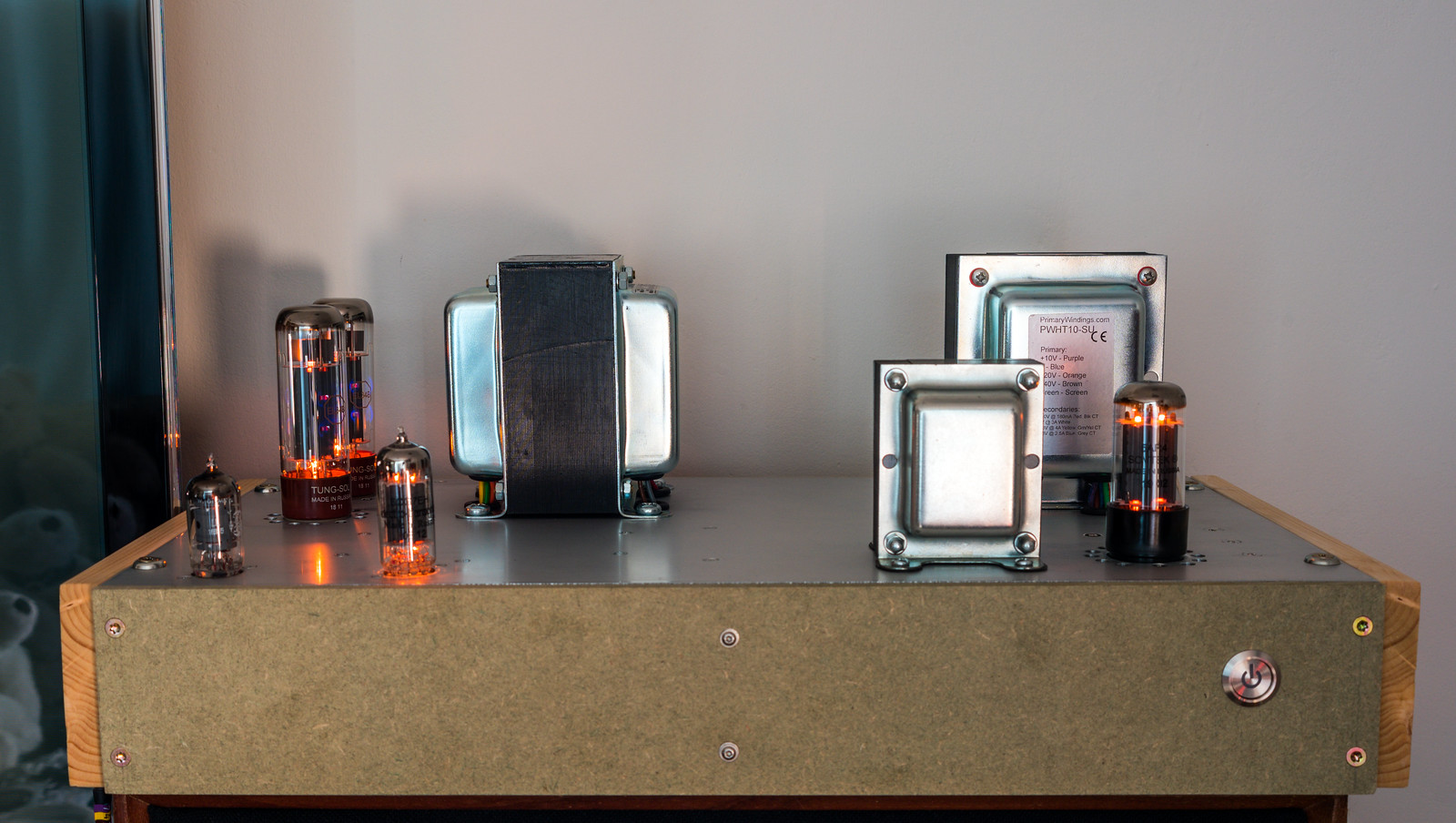



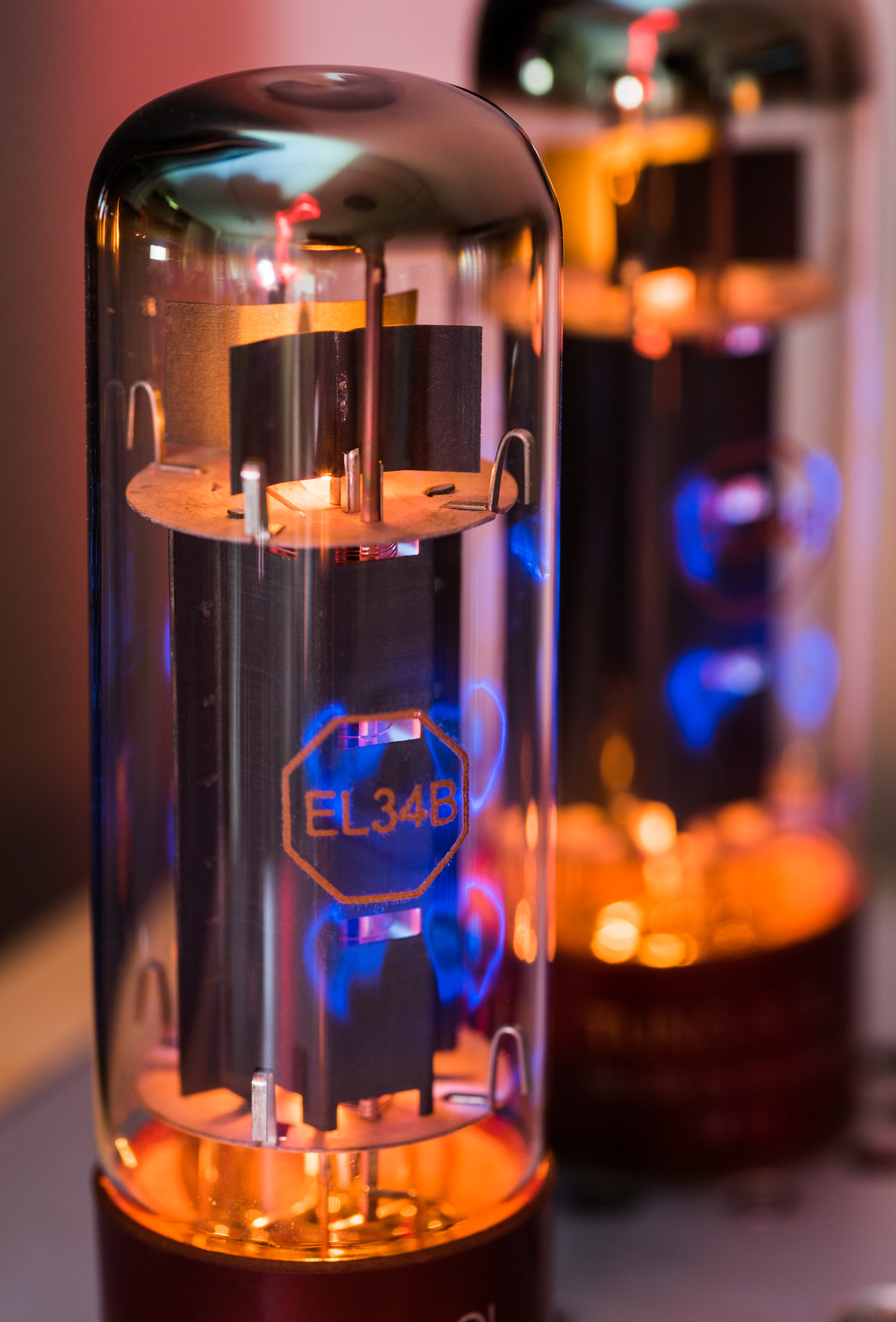
I think I may be a better photographer than amp builder. I'm extremely pleased with it. I still need to build this design into a new more compact chassis Mk4 final build as a pair.





Hi kei:
Did you use an lm317 as a CCS for cathode bias? If so what current did you use?
Can you post the whole schematic?
I also use ccs cathode bias on my 12SL7GT - 6V6VGT single-end, set for 46ma.
http://pbpix.com/amp/se%2012sl7%206v6%20toroid%20final%20may%2029th%20'18.png
[url]http://pbpix.com/amp/se%2012sl7%206v6%20%20tubes.jpg
[/URL]
Did you use an lm317 as a CCS for cathode bias? If so what current did you use?
Can you post the whole schematic?
I also use ccs cathode bias on my 12SL7GT - 6V6VGT single-end, set for 46ma.
http://pbpix.com/amp/se%2012sl7%206v6%20toroid%20final%20may%2029th%20'18.png
[url]http://pbpix.com/amp/se%2012sl7%206v6%20%20tubes.jpg
[/URL]
Last edited:
The CCS is a basic NPN based affair in the tail of the phase splitter. There are no other CCS's for the other valves in the amp. The outputs have a combination bias between cathode bias and fixed bias. (using 24V 5W zeners in series with 220R resistors)Hi kei:
Did you use an lm317 as a CCS for cathode bias? If so what current did you use?
Can you post the whole schematic?
I also use ccs cathode bias on my 6v6vgt SE set for 46ma.
http://pbpix.com/amp/se%2012sl7%206v6%20toroid%20final%20may%2029th%20'18.png
The full schematic is here.
The Nixie finally arrived!
IN-8-2 nixies? looks nice
IN-8-2 nixies? looks nice
IN-8 (short pins, not flying leads) with sockets.
Silly Me.
And I thought a 3rd alternative was that those were special "Compressor" EL34 tubes.
How does that sound?
More seriously, it sounds great. It might sound a bit like an insult to a tube amp, but it sounds extremely similar to the solid state amp it's replacing. It may have a slightly tubbier bottom end that I'd say may be attributable to the significant reduction in damping factor. I can't hear a jot of difference between those EL34's and the KT77's.
Kei,
They got the specs and performance of the EL34 and KT77 to match so well, that you would not know that one is a true Pentode, and one is a true Beam Power tube.
Suppressor grid, and Beam Formers respectively.
And, "Global Negative Feedback Covers a Multitude of Sins", stolen by me, and modified for tubes.
I love that 100mm Macro Photo.
I have lens adapters for my mirrorless cameras (1.5x, 1.6x and 2.0x crop sensors).
I have classic macro lenses, three 50mm f3.5, one 55mm f3.5, one 60mm f2.8, and one 90mm f2, only two are of the same brand (and are 50mm).
No money to dedicate the purchase of an Anamorphic lens. But if I had one, I hate software and software manipulation (so any photos with such lens would stay intrinsically compressed). Try that with the forum compressor, and get double compression!
They got the specs and performance of the EL34 and KT77 to match so well, that you would not know that one is a true Pentode, and one is a true Beam Power tube.
Suppressor grid, and Beam Formers respectively.
And, "Global Negative Feedback Covers a Multitude of Sins", stolen by me, and modified for tubes.
I love that 100mm Macro Photo.
I have lens adapters for my mirrorless cameras (1.5x, 1.6x and 2.0x crop sensors).
I have classic macro lenses, three 50mm f3.5, one 55mm f3.5, one 60mm f2.8, and one 90mm f2, only two are of the same brand (and are 50mm).
No money to dedicate the purchase of an Anamorphic lens. But if I had one, I hate software and software manipulation (so any photos with such lens would stay intrinsically compressed). Try that with the forum compressor, and get double compression!
Last edited:
What I am doing now. A tube, but not vacuum. 
What I am doing now. A tube, but not vacuum.
I opened a thread in a "Vendor Bazaar".
For vacuum tubes I do not have a space in the trailer where I stay temporary. But I will find some and continue working on my preamp+
What I am doing now. A tube, but not vacuum.
I opened a thread in a "Vendor Bazaar".
For vacuum tubes I do not have a space in the trailer where I stay temporary. But I will find some and continue working on my preamp+
Attachments
Format, vertical
I add my uniqueness to the collective...
I never liked the standard amp-on-a-plate but I like having access to the live/working amp.
In the picture, next to the speakers are an attempt to just slide the amp into a case, which works. It allows one to access the whole amp after some careful unfastening the whole amp is accessible.
The ones nearer the center, 2’ x 2’ x 5” have one whole side that is removable. This is a great plan and skips the need for a stand 😀 It’s also a step away from mono block construction and uses an umbilical which I feel is progress... the twin mono block deal has a limited payoff for the expense, complexity and weight.
I think I’ve found my format!
I add my uniqueness to the collective...
I never liked the standard amp-on-a-plate but I like having access to the live/working amp.
In the picture, next to the speakers are an attempt to just slide the amp into a case, which works. It allows one to access the whole amp after some careful unfastening the whole amp is accessible.
The ones nearer the center, 2’ x 2’ x 5” have one whole side that is removable. This is a great plan and skips the need for a stand 😀 It’s also a step away from mono block construction and uses an umbilical which I feel is progress... the twin mono block deal has a limited payoff for the expense, complexity and weight.
I think I’ve found my format!
Attachments
Kei,
No money to dedicate the purchase of an Anamorphic lens.
I believe there is a tutorial somewhere online on how to convert an old Helios lens into an anamorphic lens (those go for <50)
6J4+2A3 SE amp
Congrats, great looking and apparently performing thing it is!
gideon1990,
Thanks!
I used to have a Helios 58mm f2.0 lens.
The conversion to Anamorphic is not real.
It adds Streaking, and Flare characteristics that many Anamorphic lenses have.
But the conversion does not compress the picture in the x direction, and leave the y direction uncompressed.
A normal 35mm full frame lens like the Helios 58mm f2.0 has equal magnification in both x and y directions. The aspect ratio is 3:2, but is linear.
The film is 36mm by 24mm, which is the 3:2 aspect.
An anamorphic compresses the x direction, making the lens more of a wide angle lens in x.
Cinemascope is taken with an Anamorphic lens, and then the projection lens de-compresses the x direction, giving a higher aspect ratio than 3:2.
I think a 50mm Anamorphic lens takes in about 35mm wide angle lens view in the x direction, but only a 50mm view in the y direction.
Our ships projectionist used to play a joke, and start the evening movie with the wrong lens. The picture appeared either thin and tall, or fat and short.
Then he would change to the correct lens, and start the movie over.
When you are out to sea for 30 days at a time, a few jokes are in order.
Thanks!
I used to have a Helios 58mm f2.0 lens.
The conversion to Anamorphic is not real.
It adds Streaking, and Flare characteristics that many Anamorphic lenses have.
But the conversion does not compress the picture in the x direction, and leave the y direction uncompressed.
A normal 35mm full frame lens like the Helios 58mm f2.0 has equal magnification in both x and y directions. The aspect ratio is 3:2, but is linear.
The film is 36mm by 24mm, which is the 3:2 aspect.
An anamorphic compresses the x direction, making the lens more of a wide angle lens in x.
Cinemascope is taken with an Anamorphic lens, and then the projection lens de-compresses the x direction, giving a higher aspect ratio than 3:2.
I think a 50mm Anamorphic lens takes in about 35mm wide angle lens view in the x direction, but only a 50mm view in the y direction.
Our ships projectionist used to play a joke, and start the evening movie with the wrong lens. The picture appeared either thin and tall, or fat and short.
Then he would change to the correct lens, and start the movie over.
When you are out to sea for 30 days at a time, a few jokes are in order.
Last edited:
You can't convert "usual" (spherical) lens to anamorphic without completely redesigning it optically. You can convert the lens to quasi-anamorphic though - it'll provide anamorphic-looking special effects like streak flares and oval bokeh bubbles without actually morphing anything.I believe there is a tutorial somewhere online on how to convert an old Helios lens into an anamorphic lens (those go for <50)
- Home
- Amplifiers
- Tubes / Valves
- Photo Gallery
